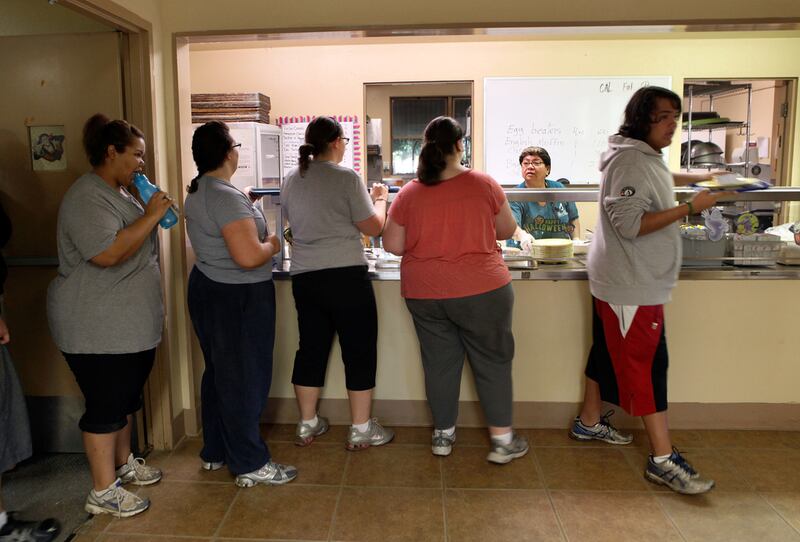More than half of the pupils in UAE schools are classed as overweight or obese. Weight problems are even being identified in infants.
Warnings such as these are becoming alarmingly common and leave little doubt that childhood obesity in the country has reached epidemic proportions.
These particular findings come from a 2015 study by Mohammed bin Rashid School of Government. As well as discovering that 14 per cent of 15 to 18-year-olds are obese and 38 per cent overweight, it found the frequency of youth obesity in the UAE is three times greater than recommended global levels.
The World Health Organization last year predicted that by 2025 the number of overweight children in the Emirates between the ages of 5 and 19 will soar to 448,736, if current trends continue.
“An overweight child is always a concern as it sets the path for adult obesity,” says Dr Medhat Abu-Shaaban, a consultant in paediatrics and allergies, and medical director at My Pedia Clinic, Dubai.
“We are seeing so many problems in young children who are overweight or obese: more incidents of Type 2 diabetes, asthma, joint problems and depression. Once they get older, there is a higher risk of things like metabolic disease, hypertension and heart disease.”
Some parents are reluctant to admit their child has a weight problem, or are simply ignorant of the issue, says Dr Mirna Sabbagh, a nutritionist and dietitian at the clinic.
“Many parents do not know their children are suffering from obesity,” she says. “I even have patients asking me if their child is underweight when they are, in fact, obese.
“For children under 3, there are WHO growth charts that health-care providers and parents can follow. They compare the child’s weight with the average weight globally and will show if it is too low, exactly right, or too high for their age.
“More importantly, there is another chart that compares the child’s weight for their height, which determines their body mass index. In this way, a child who seems overweight compared with the global average for their age may in fact have the correct weight for their height.”
The diagnosis of obesity is based on this BMI and while there are many calculators available online, it is most accurately determined by a paediatrician.
“For children over 3, we will take into consideration their waist and other bodily measurements, as well as checking their muscle and fat mass,” says Sabbagh.
She and Abu-Shaaban advise parents to monitor their children’s weight and height on a monthly basis during the younger years, and every three to six months when they are older, to make sure there are no big weight increases.
“Controlling weight gain from the beginning is so important, before it creates several metabolic changes that become harder to reverse,” says Sabbagh.
Abu-Shaaban adds: “While childhood obesity can be genetic, the major cause, I believe, in our current generation is the use of electronic gadgets such as computers, iPads and iPhones. Children sit and snack on unhealthy food and are not getting the physical activity they need.”
A report by the Centers for Disease Control and Prevention in the United States highlights this trend, revealing that only 27 per cent of high-school students get 60 minutes of physical activity a day, while 41 per cent played video games for more than three hours a day. Thirty-two per cent spent more than three hours watching television each day.
“This lack of physical activity is a huge worry,” says Claire Peirson, a psychotherapist at Pivotal Mind. She conducted extensive research into the subject of children, physical activity and the link to mental well-being as part of her master’s degree in applied positive psychology.
“Children only need to move their bodies for an hour a day to help combat this. It doesn’t have to be a strong gym workout – it just means getting active with simple things like climbing the stairs or walking.”
A gentle approach to dealing with childhood obesity is more effective than embarking on a strict diet or exercise regime, says Peirson.
“I’ve worked with many young people with anxiety, and who are bullied or lack confidence due to being overweight or obese,” she says. “Our sessions rarely talk about food. Instead I look at their underlying problems, such as low self-esteem, first to help them start to think better about themselves.
“Exercise shouldn’t be seen as a punishment. If it is too hard or too ambitious, children will feel like they are setting themselves up for failure.”
Getting children into a better frame of mind is crucial to helping tackle the problem.
“Encouraging the mindset that they can exercise, that they’ve got time to do so and helping them to create that habit is so important,” says Peirson.
“Ask your child what they would like to do and help them turn ‘won’t’ into ‘will’ – for example, changing: “I won’t ever lose weight” to “I will move my body every day.”
“Above all, encourage your child to believe in themselves and take responsibility for their own health and happiness.”
artslife@thenational.ae





